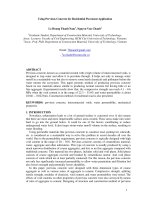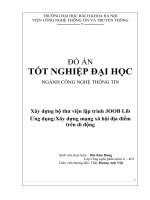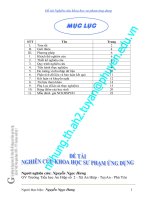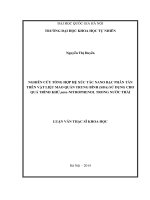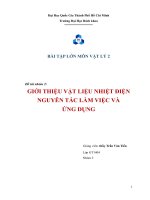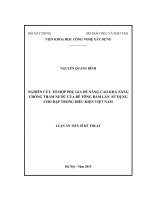Sử dụng bê tông thấm nước cho khu dân cư Pavelý ứng dụng
Bạn đang xem bản rút gọn của tài liệu. Xem và tải ngay bản đầy đủ của tài liệu tại đây (409.98 KB, 7 trang )
1
Using Pervious Concrete for Residential Pavement Application
Le Hoang Thanh Nam
1
, Nguyen Van Chanh
2
1
Graduate Student, Department of Construction Material, University of Technology,
Assoc. Lecturer, Faculty of Civil Engineering, HCM City University of Technology, Vietnam;
2
Assoc. Prof. PhD, Department of Construction Material, University of Technology, Vietnam
Email:
1
,
2
ABSTRACT
Pervious concrete, known as a material created with a high volume of interconnected voids, is
designed to trap water and allow it to percolate through. It helps not only to manage water
runoff in a sustainable way but also to remove some harsh chemicals and pollutants before the
water returns the ecosystem. This paper presents method of producing pervious concrete
based on raw materials almost similar to producing normal concrete but having little or no
fine aggregate. Experimental results show that, the compressive strength can reach 4.1 – 8.6
MPa when the void content is in the range of 22.3 – 33.6% and water permeability is about
0.0141 – 0.0223m/s. Construction method of residential road is also presented.
KEYWORDS: pervious concrete, interconnected voids, water permeability, mechanical
properties.
1. INTRODUCTION
Nowadays, urbanization leads to a lot of ground surface is concreted over. It also means
that there are more and more impermeable surface areas created. These areas make rain water
hard to go into the ground below. It could be one of the factors contributing to reduce
underground water level. It also keeps storm-water runoff volume on the surface, resulting in
water flooding.
Using permeable materials like pervious concrete to construct road, parking lot, sidewalk,
etc. is considered as a sustainable way to solve this problem in recent decades all over the
world. Due to the permeability requirement, pervious concrete is typically designed with high
void content in the range of 20 – 30%. Pervious concrete consists of cementitious material,
water, aggregate and often admixtures. This type of concrete is usually produced by using a
much narrower distribution of coarse aggregates, and less or no fine aggregate compared with
traditional concrete. This material has two phases, includes solid and void phase. Solid phase
consists of coarse aggregate covered and bonded by cementitious mortar. And void phase
consists of voids which are at least partially connected. For this reason, the pervious concrete
not only has significantly increased permeability to allow water penetration and filtration but
also lowers strength and potentially lowers durability.
In this paper, pervious concrete were designed with three dimension types of coarse
aggregate as well as various ratios of aggregate to cement. Compressive strength, splitting
tensile strength, modulus of elasticity, void content, and water permeability were tested. The
effects of void contents on other properties of pervious concrete were also surveyed by means
of ratio of aggregate to cement. Designing of structure and construction method of pervious
2
concrete pavement for residential road was also presented. The following sections describe
the detailed experiments, test results, and major findings.
2. MATERIALS AND METHODS
2.1 Materials
Portland cement was used in all mixes.
Crushed stone which passed the 19.0mm sieve but retained on the 4.75mm sieve was used
as coarse aggregate. They are separated into three groups as shown in table 1 below.
Table 1.Groups of coarse aggregate
Group of coarse
aggregate
Retaining sieve
(mm)
Passing sieve
(mm)
A 4.75 9.5
B 9.5 12.5
C 12.5 19.0
2.2 Mix proportions
Mix proportions are designed based on the specified ratios of coarse aggregate to cement;
ratio of water to cement and retarding admixture to cement are fixed as 0.33 and 0.1
respectively. Because the hardening time of pervious concrete is relatively short, it is
necessary to use retarding admixtures in mixture. Experimental samples’ mix proportions are
shown in Table 2.
Table 2.Mix proportions
Group of
Coarse
Aggregate
Mix
Cement
(C)
(kg/m
3
)
Water
(W)
(lit/m
3
)
Coarse
Aggregate
(A) (kg/m
3
)
A/C W/C R.A.
(*)
/C
A (D
min
=
4.75mm)
A45
199.8 65.93 899.10 4.5 0.33 0.1
A50
179.82 59.34 899.10 5.0 0.33 0.1
A55
163.47 53.94 899.10 5.5 0.33 0.1
A60
149.85 49.45 899.10 6.0 0.33 0.1
B (D
min
=
9.5mm)
B45
205.8 67.91 926.10 4.5 0.33 0.1
B50
185.22 61.12 926.10 5.0 0.33 0.1
B55
168.38 55.56 926.10 5.5 0.33 0.1
B60
154.35 50.93 926.10 6.0 0.33 0.1
C (D
min
=
12.5mm)
C45
210.0 69.30 945.00 4.5 0.33 0.1
C50
189.1 62.37 945.00 5.0 0.33 0.1
C55
171.81 56.70 945.00 5.5 0.33 0.1
C60
157.5 51.97 945.00 6.0 0.33 0.1
(*)
Retarding admixture
2.3 Specimen preparation
The mixing procedure has to be considered to increase the bond between cement paste and
aggregate. First of all, a small amount of cement (5 – 10%) was mixed with aggregate in dry
state for 1 – 2 minutes. Then, water and the remaining cement were added to the mixer. The
mixture was then mixed for about 2 minutes, rested for 2 minutes, and then mixed for 2
minutes before casting.
3
Specimens were placed in cylindrical molds for splitting tensile strength, compressive
strength, elastic modulus, and water permeability tests (Figure 1).
2.4 Water permeability test
2.4.1 Testing apparatus
Water permeability of pervious concrete samples was determined by an apparatus
described as Figure 2 below. It has a plastic pipe called “penetration pipe” with 95mm in
inner diameter and 250mm in length. The top part of penetration pipe is 150mm long,
encloses the specimen. This pipe is connected with a drainage pipe of 49 mm in diameter
through a valve of also 49 mm in diameter according to the principle of communicating
vessels. Top of drainage pipe is 10mm higher than top of the installed specimen. The
apparatus also contains a pipe with scale division from 0 to 300mm used to observe water
level during experiment process.
2.4.2 Procedure of testing
Cylindrical specimen of pervious concrete with [diameter] x [length] = 95mm x 150mm is
wrapped by a latex coat before placed in penetration pipe. Soak specimens for 24 hours in
water in order to exclude the air in holes of pervious concrete. Close valve then pour water
into division pipe so that the water level is at 300mm. When the valve is opened, water
penetrates through the concrete specimen and goes to drainage pipe according to the principle
of communicating vessels. Determine the time t (seconds) of changing water levels from 290
mm high (h
1
) to 70 mm high (h
2
). The experiment is repeated three times; three values are
determined including t
1
, t
2
, t
3
respectively. Get the average time over 3 period values.
Figure 1. Produced pervious concrete specimens Figure 2. Water permeability test setup
2.4.3 Calculating
Coefficient of permeability (K) is calculated by Darcy's law:
⎟
⎟
⎠
⎞
⎜
⎜
⎝
⎛
=
2
1
2
1
lg
.
h
h
tA
LA
K
Where: A
1
is cross sectional area of the standpipe; A
2
is cross sectional area of specimen; L is
the length of specimen; t is time in seconds from h
1
= 290mm to h
2
= 70mm.
3. RESULTS AND DISCUSSION
4
Test results of physical and mechanical properties of mix samples are summarized in table 3
below.
Table 3.Summary of test results
Mix
Void
content
(%)
Permeability
(m/s)
Compressive
strength
(MPa)
Splitting tensile
strength
(MPa)
Elastic
modulus
(MPa)
A45 22.3 0.0141 8.60
3.42
40712
A50 23.7 0.0147 7.42
3.16
35126
A55 24.0 0.0158 6.41
2.52
30345
A60 24.8 0.0164 6.22
2.14
28404
B45 23.0 0.0171 7.60
2.86
35978
B50 24.4 0.0177 7.16
2.60
33895
B55 25.6 0.0186 6.04
1.25
28404
B60 26.7 0.0192 4.80
1.10
22723
C45 27.0 0.0203 7.53
2.80
35647
C50 29.3 0.0212 6.92
2.53
32759
C55 32.4 0.0216 5.80
1.02
27457
C60 33.6 0.0223 4.10
0.94
18936
3.1 Void content of pervious concrete
Surveying all three groups of mix proportion corresponding to three groups of coarse
aggregate, it has been shown that the void content increases when the ratios of aggregate –
cement increases from 4.5 to 6.0. It was also found that the larger sizes of coarse aggregate,
the higher void content of pervious concrete (Figure 3). The minimum and maximum void
content of these samples are 22.3% and 33.6%, respectively.
When types of larger coarse aggregate are used, holes between them increase in size. It
causes a higher void content of pervious concrete.
When the ratio of coarse aggregate/cement increases, it means that the amount of
cementitious material reduces. This amount is so small that it’s just enough to cover aggregate
particles and create connection among them. It also means that there is very little cement
paste filling the gaps among particles, results in a high void content of pervious concrete.
However, the increasing of void content is limited when there is too little cement paste in the
mixture. There is no cementitious material to fill the gaps and almost not enough to connect
particles. It causes not only the reducing in strength of concrete but also the difficulty in
mixing process.
3.2 Permeability of pervious concrete
The most important property of pervious concrete is the permeability. Experimental testing
shows that permeability of specimens varies in the range of 0.0141 to 0.0223m/s. It’s also
influenced by aggregate particles’ size and ratio of coarse aggregate/cement. According to test
results, coefficient of permeability is higher when D
min
of aggregate particles is higher in the
range of 4.75 to 12.5mm. This coefficient also increases when the ratio of coarse aggregate to
cement varies from 4.5 to 6.0. It’s clear to realize that the higher void content leads to the
higher permeability of concrete.
5
0
5
10
15
20
25
30
35
40
44.555.566.5
V
o
i
d
c
o
n
t
e
n
t
(
%
)
Ratio of coarse aggregate/cement
D.min = 4.75mm
D.min = 9.5mm
D.min = 12.5mm
0.000
0.005
0.010
0.015
0.020
0.025
44.555.566.5
C
o
e
f
f
i
c
i
e
n
t
o
f
p
e
r
m
e
a
b
i
l
i
t
y
(
m
/
s
)
Ratio of coarse aggregate/cement
D.min = 4.75mm
D.min = 9.5mm
D.min = 12.5mm
Figure 3. Relationship between ratio of
coarse aggregate to cement and void
content.
Figure 4. Relationship between ratio of
coarse aggregate to cement and coefficient
of permeability
3.3 Compressive strength of pervious concrete
Compressive strength depends on many parameters but most of them relate to the factor of
void content. Thus, ratio of coarse aggregate/cement has significant effects to compressive
strength as though the factor directly affects void content (Figure 5). Test results show that the
compressive strength of specimens after 28 days varies in the range of 4.1 MPa to 8.6 MPa.
0
1
2
3
4
5
6
7
8
9
10
44.555.566.5
C
o
m
p
r
e
s
s
i
v
e
s
t
r
e
n
g
t
h
(
M
P
a
)
Ratio of coarse aggregate/cement
3 days
7 days
28 days
D
min
= 4.75mm
0
1
2
3
4
5
6
7
8
4 4.5 5 5.5 6 6.5
C
o
m
p
r
e
s
s
i
v
e
s
t
r
e
n
g
t
h
(
M
P
a
)
Ratio of coarse aggregate/cement
3 days
7 days
28 days
D
min
= 9.5mm
0
1
2
3
4
5
6
7
8
4 4.5 5 5.5 6 6.5
C
o
m
p
r
e
s
s
i
v
e
s
t
r
e
n
g
t
h
(
M
P
a
)
Ratio of coarse aggregate/cement
3 days
7 days
28 days
D
min
= 12.5mm
Figure 5. Relationship between ratio of coarse aggregate to cement and compressive
strength with D
min
= 4.75mm; 9.5mm; and 12.5mm respectively
When coarse aggregate/cement ratio increases from 4.5 to 6.0, the compressive strength of
all three groups of aggregate as well as all days of age decreases. High ratio of coarse
aggregate/cement leads to little amount of cement. It causes the structure of the hardened
cement paste to weaken and thus the concrete strength significantly reduces. However, the

